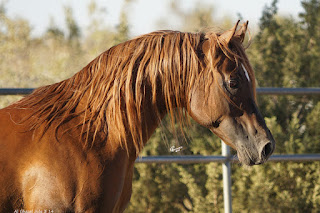Here we are, once again, at the doorstep of a new year! Before we get into the most favorite blogs of 2022, let's do a little housekeeping, as far as the stats are concerned. I added 64 more blogs this year, 80% of them were original, newly written and published for 2022. In return, you visited the blog 26,000 times this year! As a result, all for the love of a horse blog was included in FeedSpot's top 10 list of Arabian Horse Blogs and Websites of 2022! We were #7:
There are several ways to present the list of favorite blogs. If I just rank the blogs by the number of page views received, regardless of when they were published, the most popular blogs in 2022 are:
- The Straight Babson Egyptian Arabian Horse
- A Fascinating Son: *Ibn Safinaz 1981 - 2008
- Ameer El Koloob
- Gulastra, Mesaoud & Egypt
- Nehaya: Off the Richter Scale
However, the ranking, as I explained, considers all blogs, regardless of the publishing date. What would the list look like if we limited the page views to only the newly written and published blogs for 2022? It's interesting that #3, 4 & 5 from the list above, now become #1, #2 & #3 below:
In the summer of 2023, all for the love of a horse will be 17 years old! How do the favorite blogs of 2022 compare with the all-time favorite blogs? Only the Babson blog, your favorite blog of 2022, is the 2nd favorite blog of all time!
- Butterfly
- The Straight Babson Egyptian Arabian Horse
- Bedouin Beauty: Jibbah
- Aneesilnefous Ezzain
- Bedouin Beauty: The Soulful Eye of the Arab Horse
The "honorable mentions" for older blogs who made it into the 2nd half of the 2022 top ten favorites:
This year, I thought to ask myself which blogs were my personal favorites:
- The Laheeb blog in the spring of 2022 helped me to deal with the sadness I felt, after learning of Laheeb's death. Laheeb was special to me, his courage in the face of adversity was inspiring and I hope you were touched by his story.
- A reader of this blog had asked me to name my favorite mare. With so many beautiful mares to choose from, I thought this an impossible task. And what does favorite really mean? I hope my Fa Halima blog will inspire you with the same awe and wonder that I feel for this unbelievable mare.
- I have wanted to write a blog about *Ibn Hafiza for a long time but the words just never felt right. I have danced around the topic for a while, authoring blogs on his granddam, Mahfouza, his dam, Hafiza and his daughter, Nagliah, in addition to a blog about horses whose pedigrees do not contain the Blunt desert-bred horses. I am so happy to finally pull it all together and tell what I believe, is his unique story.
- Ekstern's story is also the story of his sire, Monogramm and the many people who worked diligently behind the scenes to bring Monogramm to Poland. Ekstern is the kind of horse who appeals to a wide variety of people, regardless of bloodline. He was an unbelievable sire, his daughters matured into valuable mares of great influence, all over the world A senior-aged horse at the time of his death, it was still a shock to learn of his death.
- The YouTube thumbnail for the Arabian Essence video of the Spanish Arabian stallion, Fanatico, competing at the AECCA show in October, inspired me to also write the blogs on Titanic and Tarambana Qahira. However, writing these blogs made me more aware of the plight of the Spanish bloodlines and how close we are to losing many of the lines forever. Less than 1 percent of the total Arabian horse population is represented by Spanish Arabians. They are rarer than you believe. Martina Minhard, the breeder of Tarambana Qahira, has been very outspoken on the impending extinction of these lines. I hope my blogs will inspire someone towards the preservation of these lines, sooner rather than later.






.jpeg)






.jpg)






















-Oct-6-20---11-y-old.jpg)

